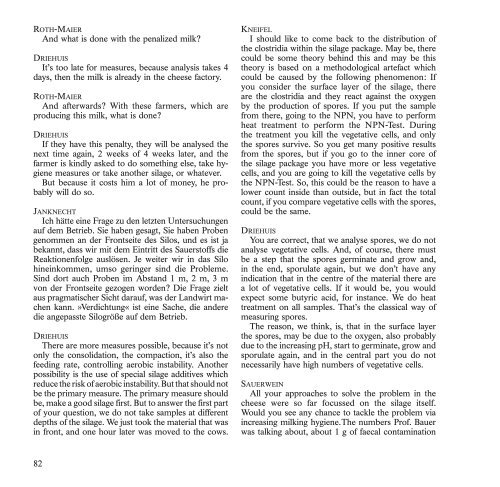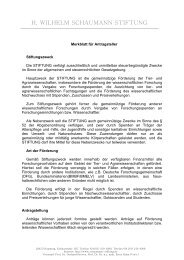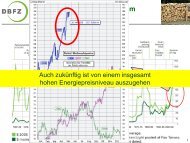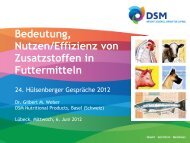Broschüre 2004 zum Download (pdf | 1994,28 KB) - H. Wilhelm ...
Broschüre 2004 zum Download (pdf | 1994,28 KB) - H. Wilhelm ...
Broschüre 2004 zum Download (pdf | 1994,28 KB) - H. Wilhelm ...
Sie wollen auch ein ePaper? Erhöhen Sie die Reichweite Ihrer Titel.
YUMPU macht aus Druck-PDFs automatisch weboptimierte ePaper, die Google liebt.
ROTH-MAIER<br />
And what is done with the penalized milk?<br />
DRIEHUIS<br />
It’s too late for measures, because analysis takes 4<br />
days, then the milk is already in the cheese factory.<br />
ROTH-MAIER<br />
And afterwards? With these farmers, which are<br />
producing this milk, what is done?<br />
DRIEHUIS<br />
If they have this penalty, they will be analysed the<br />
next time again, 2 weeks of 4 weeks later, and the<br />
farmer is kindly asked to do something else, take hygiene<br />
measures or take another silage, or whatever.<br />
But because it costs him a lot of money, he probably<br />
will do so.<br />
JANKNECHT<br />
Ich hätte eine Frage zu den letzten Untersuchungen<br />
auf dem Betrieb. Sie haben gesagt, Sie haben Proben<br />
genommen an der Frontseite des Silos, und es ist ja<br />
bekannt, dass wir mit dem Eintritt des Sauerstoffs die<br />
Reaktionenfolge auslösen. Je weiter wir in das Silo<br />
hineinkommen, umso geringer sind die Probleme.<br />
Sind dort auch Proben im Abstand 1 m, 2 m, 3 m<br />
von der Frontseite gezogen worden? Die Frage zielt<br />
aus pragmatischer Sicht darauf, was der Landwirt machen<br />
kann. »Verdichtung« ist eine Sache, die andere<br />
die angepasste Silogröße auf dem Betrieb.<br />
DRIEHUIS<br />
There are more measures possible, because it’s not<br />
only the consolidation, the compaction, it’s also the<br />
feeding rate, controlling aerobic instability. Another<br />
possibility is the use of special silage additives which<br />
reduce the risk of aerobic instability. But that should not<br />
be the primary measure. The primary measure should<br />
be, make a good silage first. But to answer the first part<br />
of your question, we do not take samples at different<br />
depths of the silage. We just took the material that was<br />
in front, and one hour later was moved to the cows.<br />
KNEIFEL<br />
I should like to come back to the distribution of<br />
the clostridia within the silage package. May be, there<br />
could be some theory behind this and may be this<br />
theory is based on a methodological artefact which<br />
could be caused by the following phenomenon: If<br />
you consider the surface layer of the silage, there<br />
are the clostridia and they react against the oxygen<br />
by the production of spores. If you put the sample<br />
from there, going to the NPN, you have to perform<br />
heat treatment to perform the NPN-Test. During<br />
the treatment you kill the vegetative cells, and only<br />
the spores survive. So you get many positive results<br />
from the spores, but if you go to the inner core of<br />
the silage package you have more or less vegetative<br />
cells, and you are going to kill the vegetative cells by<br />
the NPN-Test. So, this could be the reason to have a<br />
lower count inside than outside, but in fact the total<br />
count, if you compare vegetative cells with the spores,<br />
could be the same.<br />
DRIEHUIS<br />
You are correct, that we analyse spores, we do not<br />
analyse vegetative cells. And, of course, there must<br />
be a step that the spores germinate and grow and,<br />
in the end, sporulate again, but we don’t have any<br />
indication that in the centre of the material there are<br />
a lot of vegetative cells. If it would be, you would<br />
expect some butyric acid, for instance. We do heat<br />
treatment on all samples. That’s the classical way of<br />
measuring spores.<br />
The reason, we think, is, that in the surface layer<br />
the spores, may be due to the oxygen, also probably<br />
due to the increasing pH, start to germinate, grow and<br />
sporulate again, and in the central part you do not<br />
necessarily have high numbers of vegetative cells.<br />
SAUERWEIN<br />
All your approaches to solve the problem in the<br />
cheese were so far focussed on the silage itself.<br />
Would you see any chance to tackle the problem via<br />
in creasing milking hygiene.The numbers Prof. Bauer<br />
was talking about, about 1 g of faecal contamination<br />
82











